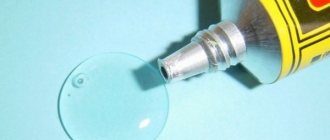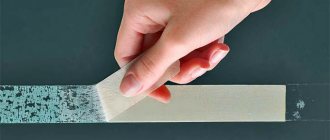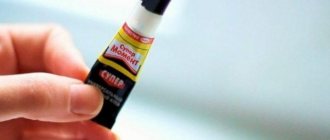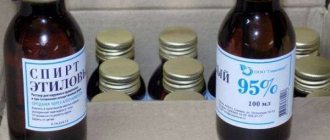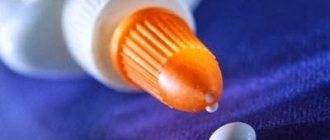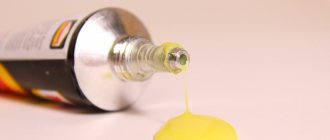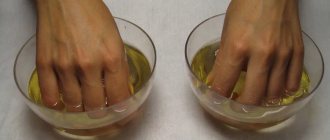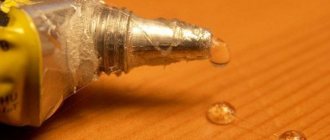Suitable for gluing most materials and drying quickly, it gives a fairly reliable connection. But if used carelessly, it can leave streaks and stains that are difficult to remove.
Special preparations and home recipes will help you deal with glue marks. In this article we will tell you how to remove super glue from various surfaces and objects.
Anticlean
Manufacturers of adhesive substances, realizing the problem, have developed special products that can also clean the products of their competitors. To achieve a positive result, it is imperative to read the instructions for using the product. Such substances are quite toxic and during their use it is advisable to observe appropriate safety measures, which are usually indicated on the packaging.
One of the popular products of its kind is Secunda anti-glue. In addition to high performance on products of the same brand, it also shows decent results on other adhesives made on the basis of cyanoacrylate. Sold in automotive and construction stores, places where household chemicals are sold, and hardware supermarkets. With its help, you can wipe off dried glue from almost any plastic surface, for example, from a phone, not to mention materials such as metal or glass.
How to remove “Moment” from a surface: which method to choose?
Superglue is a synthetic drug that is available in liquid form in small tubes designed for one-time use. When applied to a surface, it quickly sets in air, giving reliable adhesion to the material.
The adhesive property is ensured by the inclusion of cyanoacrylate in the composition . It is a water-insoluble substance that, when hardened, becomes resistant to mechanical stress and humidity.
To remove glue, it is necessary to use those means that can transform it from a solid state to a viscous one. In this form, the glue is easier to remove.
You can act on hardened glue in several ways:
| Method of influence | The essence of the method | Note |
| Mechanical | Physical mechanical impact (cutting, filing, etc. | Rough mechanical impact can lead to damage to the stained surface |
| Temperature | Application of high or very low temperature | Despite its resistance to temperature fluctuations, targeted heating leads to softening of the composition, and freezing leads to its fragility. |
| Special means | The use of purchased products that are designed to soften the adhesive and remove it | The price of such products is higher than home recipes, and the volume of product purchased is small |
| Chemicals | Homemade recipes based on drugs available in the household | Many substances that can dissolve superglue are already in the medicine cabinet, in the kitchen or around the house. |
The best cleaning result can be achieved using several methods at once, for example, softening the glue with chemicals and subsequent mechanical removal.
Soapy water
Regular soap will help remove adhesive stains from materials sensitive to aggressive solvents. Any variety of it will do, it’s especially convenient to use liquid varieties, and if they are unavailable, take a soap bar and grate it. The concentration of the solution does not require special precision - approximately 5th part of a bar per half liter of water.
- Wet the affected area with the prepared solution. For wetting, we use a small cloth, which we leave on the smudge after applying the mixture.
- After about an hour, use a rough cloth to wipe off any remaining dirt from the surface.
If the stains are not completely cleared, the procedure must be repeated.
Acetone, solvent or white spirit
Second glue is easily corroded by solvents. The process is as follows:
Add a teaspoon of solvent to a tablespoon of toothpaste and stir thoroughly;
- Apply the prepared mixture to the stain and leave for 15 minutes.
- Using a soft toothbrush, we try to wipe away traces of glue; to do this, rub the dried mixture in a circular motion.
- Use a plastic spatula to remove any remaining dirt, then wipe the surface with warm soapy water.
Aggressive cleaning liquids should be used with caution, after testing on an inconspicuous area, this is especially true for acetone.
General recommendations
The following recommendations will help you clean various surfaces efficiently:
- It is recommended to carry out technical work wearing rubber gloves in a well-ventilated area.
- The use of sharp objects, such as a knife, for cleaning can only be limited so as not to damage the surface. If the glue has hardened into a voluminous drop, then you can try to cut off the upper part, and remove the remaining trace with solvents.
- The use of serious solvents and caustic chemicals to clean the skin of your hands is not acceptable.
- Any solvent that comes into contact with human skin is harmful to health.
- For mechanical removal of superglue after exposure to solvents, it is recommended to use a plastic scraper, spatula or plastic knife. Sharp and well-sharpened instruments are used only as a last resort.
You will find all the most important and useful information about how to remove glue here.
Lemon juice
A worthy alternative to a solvent, which also will not cause harm to any surfaces being cleaned, is lemon juice or an aqueous solution of its powder concentrate. It is used to clean not only hard products. It will also easily and safely remove dried glue from the leather of boots, leatherette and other similar materials.
- Squeeze the lemon directly onto the glue stain.
- We wait 5 minutes, add more juice and clean the treated area with smooth circular movements. This is best done with a toothbrush or a rough rag.
- Remaining contaminants can be washed with warm water; it is advisable to neutralize the acid with a small amount of alkali, for example, a solution of baking soda.
In case of contact with metal
The method is the same, only the solvents themselves differ. To remove glue from metal surfaces you can use:
- Acetone.
- Alcohol.
- Undiluted vinegar.
- White Spirit.
Algorithm of actions:
- Apply the solvent to cotton wool or thick fabric.
- Apply to the stain.
- Seal with tape.
Thus, we create a “greenhouse”; the glue will heat up and can be easily removed from the surface.
Mineral motor oil
The use of such products implies that the surface being treated is resistant to oil components. Parts painted with polyurethane or acrylic paints and varnishes may lose their protective layer. Unpainted wood can be safely cleaned with oil. The process is quite simple: apply oil to the glue marks and wait half an hour. During this time, the adhesive film will soften and peel off at the edges, after which it can be removed from the affected area without much difficulty.
Mechanical cleaning of wooden products
The easiest and fastest way to remove superglue from unpainted wood is to sand it. This option has only positive aspects: it is non-toxic, it only takes a couple of minutes, the stain will disappear without a trace, there is no need to use cleaning agents or solvents. The only tool needed to successfully remove adhesive stains is fine-grained sandpaper. The finer the abrasive on the sandpaper, the smoother the wooden surface will be subsequently.
Safety precautions
When working with the substance, you should follow safety rules that will prevent the harmful effects of the composition on the human body:
- wear protective gloves;
- work in a ventilated area and wear a respirator due to toxic fumes;
- Do not use more superglue than necessary, as excess escaping may stain clothing and other items;
- when working with the adhesive for a long time, periodically pierce the tube spout with a needle or paper clip, do not try to clean it with pressure;
- to avoid burns to the mucous membrane of the eyes, the container with glue should be directed away from you and downwards;
- a tube that has been started should not be bent, as it may break at the bend line;
- Do not lean over the surface when working with superglue.
Removing adhesive traces from various surfaces is a labor-intensive process that requires care and attention. When cleaning materials, you should take into account not only their type, but also the type of spilled composition, the area of damage, and the age of the stains. Knowing all the nuances of working with wood, glass, fabric and other surfaces, you can avoid their damage and quickly tear off adhesive particles.
Rate this post
Ammonia and dish gel
A mixture of ammonia and dishwashing detergent will help remove adhesive stains from glass.
- Mix the above products in equal quantities.
- We wet a cloth or sponge in the resulting mixture and apply it liberally to the stain.
- Leave for an hour, and to prevent the treated area from completely drying out, periodically moisten it with a sponge soaked in the mixture.
- Using a thin, sharp object, carefully scrape off the remaining glue (a razor blade fixed in an eraser will do).
- We moisten a microfiber cloth with ammonia and rub the area to be cleaned.
This method will help eliminate glue and similar products.
In case of contact with plastic
Conventional solvents such as acetone can change the characteristics of the plastic, so it is recommended to take “Dimexide”, it can be found in any pharmacy.
- Soak a cotton swab in dimexide.
- Rub the stain until it softens and can be removed.
Important! Do not soak the stain. Otherwise, the plastic itself may be affected by the solvent.
You can also use ethanol, it is less effective, but does not dissolve the plastic or change its color.
Medical alcohol
It is especially effective in cases of contamination from BF brand glue, since this product is made on an alcohol basis. In cases where it is necessary to get rid of traces of superglue, achieving the desired result will require a little more time and effort, but the task will be solved. Sequencing:
- Soak a cloth in 96% rubbing alcohol and wipe the stain.
- We do this until the dirt softens and its edges begin to peel off from the surface.
- We remove the residues mechanically; if any fragments cannot be cleaned, re-wet them with alcohol, and then wipe the treated area with warm water.
First actions
If trouble happens, you need to try to prevent the stain from drying out. After all, then it will be much more difficult to get him out. It will not only cover a large area, but will also glue other sections of the material together.
Remove soiled clothing and spread it on a horizontal surface. Avoid tilting, otherwise the glue will “float”. Place any hard object (cardboard, plate, thick paper) under the blot on the underside of the item; it will prevent the stain from seeping further through the fabric.
After carrying out the procedures to save the rest of the clothing, you can begin to remove the stain that has already appeared. If the material on which the glue is spilled is dense, the stain may not be absorbed and will remain completely on the surface. Then, after it dries, it will not be difficult to scrape off the dry mass with the blunt side of a knife. But in the case when the fabric is thoroughly saturated, other means will come to the rescue.
Petrol
Any fuel will do, including those sold at gas stations; you can use kerosene, diesel fuel, or lighter fluid. With the help of these products, glue is perfectly removed from plastic without any negative consequences for it.
- Apply the liquid to the contaminated area.
- We wait a few minutes until the film softens.
- Wipe with a cloth or scrape off with a plastic spatula. Remaining dirt can be cleaned with soapy water.
Household or car windshield wiper
This method will work for minor glue stains, especially with adhesives that contain alcohol.
- Apply liquid to the stain directly from the spray bottle that comes with containers containing glass cleaning products.
- After a couple of minutes, wipe with a hard rag; if you cannot completely remove the glue, repeat the procedure.
The main feature of superglue
Superglue was invented in the mid-twentieth century in America as a result of experiments to create a material for optical sights. The resulting substance did not meet the requirements of the developers, but due to its super property of instantly gluing everything together, it was patented. Superglue, Super Moment, and Second contain one substance that can instantly harden when interacting with the slightest particles of moisture from the air. This is cyanoacrylate. It immediately bonds the surfaces it comes into contact with. Moreover, the gluing is very strong. Therefore, removing traces of glue is quite problematic.
Superglue of any brand contains cyanoacrylate as a base.
Unfortunately, this glue can stick to any surface, so you need to work with it very carefully. You can wipe the stain off the surface if it is not cotton or wool, with which the glue can react violently before it ignites.
Removing adhesive stains from the skin of your hands
It is not so easy to wipe off superglue from the surface of the skin; ordinary water will not help here, especially cold water, which makes the glue harden even faster, and it will be somewhat more difficult to remove it. Anti-glue products are quite toxic and should not be used on the skin.
100% way to remove glue from skin - video:
Soap, warm water and pumice stone
Dissolve a little liquid soap in a container with warm water and place your hands there for 5 minutes. Then we take pumice and slowly rub the affected areas, periodically immersing our hands in water. In case of extensive contamination, it is most likely impossible to wipe off all the glue at once, so it is necessary to divide the procedure into several stages. During breaks, your hands need to be moisturized with creams, which will also help clean them of the adhesive film.
Dimexide
Another effective way to remove superglue from your hands is to use dimexide. This medication is sold in most pharmacies, and with its help you can remove glue not only from the skin, but also from any other surface. However, it must be used with caution, since there is a possibility of irritation on the treated skin. In addition, dimexide easily penetrates into the tissues of the human body and there is a possibility that substances dissolved by it will also get there along with it. Therefore, it is better to save it for the most extreme case, and if you still have to use it, you need to immediately wash off the remaining product with warm soapy water after treating the stain.
Household solvents or nail polish remover
It is better not to use solvent cleaning for people with sensitive skin, otherwise, as with dimexide, irritation may occur. Do not use such products under any circumstances if there is an open wound in the area of the stain.
- We first wet the contaminated area with warm soapy water, wait a few minutes and try to mechanically remove the glue from our hands.
- We wipe the skin dry, moisten a cotton or cloth swab in nail polish remover and gently blot the stain, then repeat attempts at mechanical cleaning.
We use fat
Any cooking fat will do, including vegetable oil or margarine, but you will first have to melt it until it is suitable for rubbing. These products are absolutely harmless to the skin and are intended primarily for people prone to allergic reactions to cleaning products and especially to solvents.
- Generously lubricate the skin of your hands with oil and let it absorb.
- Over time, the adhesive film will become looser, after which you can try to remove it with your fingernail or wipe it with a rough cloth.
- If the procedure is successful, the remaining glue and oil can be washed off with warm water.
Even if there are particles of superglue left on your hands, you shouldn’t be upset; after a couple of days, the dirt will peel off without any outside help.
Top 3 special tools
If simple home methods are ineffective, you can use special purchased medications. They are distinguished by high efficiency and quick achievement of results.
Anticlay Super Moment
“Super Moment Antiglue” is one of the most popular and popular drugs that can dissolve superglue. It is produced in small tubes of 5 grams. The product is sold in a sealed tube, which costs about 120 rubles.
Right before use, a cap is screwed onto the tube, which pierces the factory sealed membrane. Using the thin nose of the nozzle, anti-glue is applied to the required area.
After the solvent has worked and the glue has softened, it is carefully collected with a plastic scraper and removed from the surface. To avoid streaks, the area where the stain was is wiped and dried.
The great popularity of anti-glue is explained by its advantages:
- efficiency;
- affordable price;
- ease of use.
Despite the small volume, the amount of anti-glue placed in the tube is generally enough to remove stains caused by using one tube of superglue.
Second Anticley
The remover comes in small packaging – 3 grams per tube. Cost – from 60 rubles per tube. The product allows you to remove stains accidentally left by glue and eliminate improper gluing of materials.
Application is very simple:
- Apply to surfaces stained with glue.
- Wait 60 minutes.
- Clean the surface.
The product is very easy to use, inexpensive, and effective. But if a fairly large area of the object is stained with glue, you will need 2-3 tubes of anti-glue.
Cleaner Contact
The manufacturer produces the cleaner in two types of packaging:
- Bubble with a brush.
- Tube with nozzle.
In both cases, the Contact is well applied and distributed. The drug costs about 100 rubles. A small volume is sufficient for one use in most cases.
Contact is applied to the glue stain and left for several hours to allow the reaction to take place and the adhesive mass to become plastic. The product in the package is completely ready for use.
If the surface is not cleaned properly the first time, the application of the cleaner can be repeated. This situation can arise with thick, old superglue drips.
